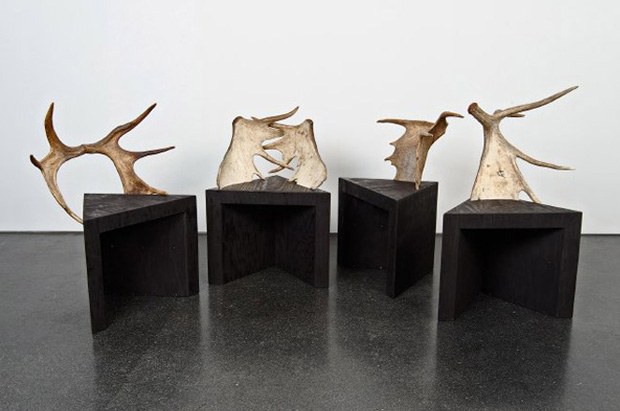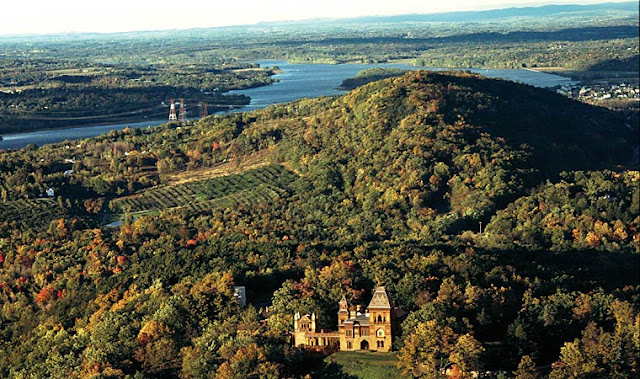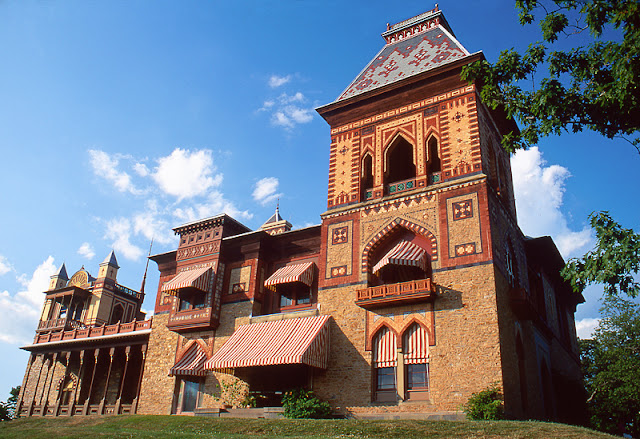I follow fashion not as a "fashionista" (whatever that means) but the way some people follow art or artists, and I think fashion designers at the highest level are indeed creating conceptual art. And one of my favorite conceptual fashion designers is the incomparable Rick Owens who has been creating wearable sculpture for some time.
But aside from clothing for men and women, he also designs furniture. Starting out as more of an accident by designing pieces for his own home and stores, his furniture designs (which are created in collaboration with his French wife Michele Lamy) are naturally reflective of his clothing. Simple, monolithic shapes dominate. His seating and objects have an ancient, Neolithic sense to them--tables seem like altars, stools and seats seem like ritual objects. This sense is highlighted by rough or elemental materials like alabaster, cement, marble, cast bronze, and plywood. To add interest, he uses hair-on-hide, leather, and moose antlers...
This is his double recamier, below, made of raw plywood and leather...
...and here it is in the living room at the Hamptons home of Dominique Lévy and Dorothy Berwin.
A Rizzoli book about Rick Owens' furniture designs called, appropriately enough, RICK OWENS: FURNITURE was released earlier this year and he and Lamy signed copies at the opening of his newest store in Manhattan in May.
To see more of Owens' work, visit his site here.
Happy designing!
Monday, November 27, 2017
Monday, November 20, 2017
Monday, November 13, 2017
Famous Homes: Olana
Frederic Edwin Church (1826--1900) was an American artist who was of the second generation of the Hudson River School and the pupil of Thomas Cole, the school’s founder. Church and his wife Isabel bought a plot of land on a hillside near the town of Hudson in New York and built a house for themselves called Cosy Cottage. When their two infant children died of diphtheria in 1865, they consoled themselves by traveling to Jamaica for six months. Upon returning, Church bought an additional 18 acres at the top of his property and began to plan a mansion based on a style that was very popular at the time, a style that is referred to as Orientalism. Although the term itself is no loner politically correct, the Victorians used this term to denote anything opposite of the Occident (the Western world) which included countries and cultures east of the Mediterranean Sea and Southern Europe. They had a preoccupation for what was to them the exotic nature of these lands. And we use this word today without malice to indicate this period of Victorian interest in motifs and designs from this part of the world.
Named after a fortress castle in ancient Greater Persia (in what is now Armenia), Olana was constructed between 1870 and 1872 after the Church's spent a year and a half traveling throughout Europe and the Middle East. When they returned home, Church hired architect Calvert Vaux and worked closely with him to realize a fanciful home based on architecture they had seen in Beirut, Jerusalem, and Damascus. The resulting stone, brick, and polychrome-stenciled villa is an unusual mixture of Victorian structural elements and Middle-Eastern decorative motifs from different times and places. In his book GEOGRAPHICAL SNAPSHOTS OF NORTH AMERICA, author Donald G. Janelle says of Olana that Moorish elements mix with contrasting Italianate themes. And the hybrid, which served not only as a home but as an artist studio as well, is unique even to the Orientalism of the period.
The official Olana website has the story of the house after Mr. Church died:
"When Frederic Church died in 1900, Olana was willed to his youngest son Louis Palmer Church. The following year Louis married Sarah Baker Good (known as “Sally”) and the two of them lived together at Olana. After Louis’s death in 1943, Sally stayed on at Olana until her death in 1964 at the age of 96. She was the last Church family member to inhabit the estate, and she willed the property to her nephew, Charles Lark. In the mid-1960s, the Hudson River School had not yet seen the revival of its popularity, and Olana was seen as a curious remnant of the Victorian era. Lark planned to sell the land and auction off the contents of the house, including all of Frederic Church’s art. The art historian David Huntington had for some years been researching Frederic Church’s art and had been visiting Olana. He learned of Mrs. Church’s death, and after ensuring that her nephew would give him a little time, began to contact individuals who might be able to assist. Olana Preservation, Inc. was formed and began the two-year task of raising funds with which to purchase the property and contents of the house.
At the end of the two-year period, Olana Preservation, Inc. had raised over half the funds necessary to purchase the property, but was unable to raise the full amount. Lark made arrangements to have the contents of the mansion put up for auction, and to sell the property to a developer. At that moment, in September of 1965, Life Magazine ran a story on Olana, with the title “Must this Mansion be Destroyed?” This galvanized local and national attention. By June, 1966 the New York State legislature under Governor Nelson Rockefeller had passed a bill authorizing the purchase of Olana, with Olana Preservation contributing the funds it had already raised. Olana opened as a New York State Historic Site in June, 1967.
Olana Preservation, Inc. disbanded, but several of its key members rejoined to start the non-profit Friends of Olana in 1971, which changed its name to The Olana Partnership in 2000. The Olana Partnership continues to play an integral part in supporting New York State Parks, Recreation and Historic Preservation’s efforts at Olana."
Here is a selection of his paintings which displays his propensity for the lyrical, the lush, the Romantic, and the exotic.
This historic home is open for tours and events. Visit the official Olana website for details.
Happy designing!
Named after a fortress castle in ancient Greater Persia (in what is now Armenia), Olana was constructed between 1870 and 1872 after the Church's spent a year and a half traveling throughout Europe and the Middle East. When they returned home, Church hired architect Calvert Vaux and worked closely with him to realize a fanciful home based on architecture they had seen in Beirut, Jerusalem, and Damascus. The resulting stone, brick, and polychrome-stenciled villa is an unusual mixture of Victorian structural elements and Middle-Eastern decorative motifs from different times and places. In his book GEOGRAPHICAL SNAPSHOTS OF NORTH AMERICA, author Donald G. Janelle says of Olana that Moorish elements mix with contrasting Italianate themes. And the hybrid, which served not only as a home but as an artist studio as well, is unique even to the Orientalism of the period.
The official Olana website has the story of the house after Mr. Church died:
"When Frederic Church died in 1900, Olana was willed to his youngest son Louis Palmer Church. The following year Louis married Sarah Baker Good (known as “Sally”) and the two of them lived together at Olana. After Louis’s death in 1943, Sally stayed on at Olana until her death in 1964 at the age of 96. She was the last Church family member to inhabit the estate, and she willed the property to her nephew, Charles Lark. In the mid-1960s, the Hudson River School had not yet seen the revival of its popularity, and Olana was seen as a curious remnant of the Victorian era. Lark planned to sell the land and auction off the contents of the house, including all of Frederic Church’s art. The art historian David Huntington had for some years been researching Frederic Church’s art and had been visiting Olana. He learned of Mrs. Church’s death, and after ensuring that her nephew would give him a little time, began to contact individuals who might be able to assist. Olana Preservation, Inc. was formed and began the two-year task of raising funds with which to purchase the property and contents of the house.
At the end of the two-year period, Olana Preservation, Inc. had raised over half the funds necessary to purchase the property, but was unable to raise the full amount. Lark made arrangements to have the contents of the mansion put up for auction, and to sell the property to a developer. At that moment, in September of 1965, Life Magazine ran a story on Olana, with the title “Must this Mansion be Destroyed?” This galvanized local and national attention. By June, 1966 the New York State legislature under Governor Nelson Rockefeller had passed a bill authorizing the purchase of Olana, with Olana Preservation contributing the funds it had already raised. Olana opened as a New York State Historic Site in June, 1967.
Olana Preservation, Inc. disbanded, but several of its key members rejoined to start the non-profit Friends of Olana in 1971, which changed its name to The Olana Partnership in 2000. The Olana Partnership continues to play an integral part in supporting New York State Parks, Recreation and Historic Preservation’s efforts at Olana."
Here is a selection of his paintings which displays his propensity for the lyrical, the lush, the Romantic, and the exotic.
This historic home is open for tours and events. Visit the official Olana website for details.
Happy designing!
Monday, November 6, 2017
Know Your Sofas: The Camelback
For this installment of "Know Your Sofas," let's take a look at a very classic sofa with a very apt name.
Thomas Chippendale brought a new sofa silhouette into vogue in the late 18th century called a camelback. One look at it and you will easily see why it was so christened. The tight-back sofa has a hump--sometimes two--and features a center and side peaks. The sinuous curve is elegant and in its purest form the sofa features exposed legs and scrolled arms. A true Chippendale camelback sofa would of course be at home in a period room but it can work extremely well in transitional or even slightly modern spaces. The camelback can also come with more contemporary details like an apron and bun feet (seen on the navy sofa in the third image down). In leather, it takes on a clubby feel like a Chesterfield sofa (previously here), and with a skirt, it seems quite homey.
Happy designing!
Thomas Chippendale brought a new sofa silhouette into vogue in the late 18th century called a camelback. One look at it and you will easily see why it was so christened. The tight-back sofa has a hump--sometimes two--and features a center and side peaks. The sinuous curve is elegant and in its purest form the sofa features exposed legs and scrolled arms. A true Chippendale camelback sofa would of course be at home in a period room but it can work extremely well in transitional or even slightly modern spaces. The camelback can also come with more contemporary details like an apron and bun feet (seen on the navy sofa in the third image down). In leather, it takes on a clubby feel like a Chesterfield sofa (previously here), and with a skirt, it seems quite homey.
Happy designing!
Subscribe to:
Posts (Atom)
















































